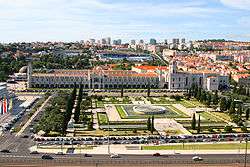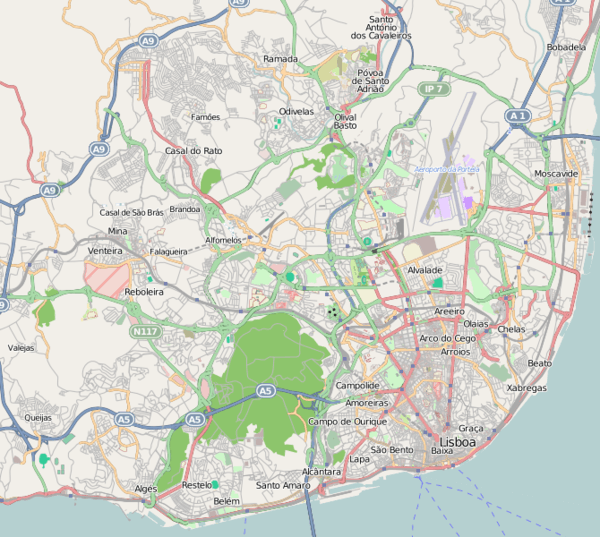Praça do Império
The Praça do Império (Empire Square) is a city square and park situated adjacent to principal monuments and tourist attractions in the civil parish of Belém, municipality and Portuguese capital of Lisbon.
Empire Square Praça do Imério | |
|---|---|
City square | |
 View of the Praça do Império in front of the Monastery of the Jeronimos | |
| Etymology: Portuguese Empire | |
| Nickname(s): Named for | |
 Empire Square Location of the manorhouse within the municipality of Lisbon | |
| Coordinates: | |
| Country | |
| Region | Lisboa |
| Subregion | Grande Lisboa |
| District | Lisbon |
| Municipality | Lisbon |
| Origin | 20th century |
| Management | Instituto Gestão do Patrimonio Arquitectónico e Arqueológico |
| Operator | Câmara Municipal de Lisboa, local administration (Article III, 23 122, 11 October 1933) |
| Status | Included in the Special Protection Zone (ZPE) of the Monastery of Santa Maria de Belém (v. IPA.00006543) |
History
_(2946096671).jpg)
.jpg)
.jpg)
Between 23 June and 2 December 1940, Lisbon realized the Exposição do Mundo Português (Portuguese World Exposition), that included an urbanization plan that encompassed the area of Belém, that included the Praça do Império.[1] The sculptures of the seahorses, that dominate the site, were completed by sculptor António Duarte were installed in 1940.[1]
A project to construct the Palácio do Ultramar (Overseas Palace) was initiated in 1952, situated on the eastern edge of the park, authored by architects Cristino da Silva and Jacques Carlu.[1]
In 1973, a commemorative monument to the poet Augusto Gil (1873-1929) was installed on the site, that included a bronze medallion and inscription by the municipal council of Lisbon.[1]
The roads around the square were used as a special stage in the 2011 to 2014 Rally de Portugal.
Architecture
The park is situated to the south of the Monastery of Santa Maria de Belém and west of the Centro Cultural de Belém.[1]
The rectangular 175 by 175 metres (574 ft × 574 ft) square consists of successive quadrangles, that structure the space into passages and greenspaces.[1] These converge in the central illuminated fountain on a square platform, covering an area of 3,300 square metres (36,000 sq ft).[1] On the extreme edges of the southern part of the square, along the Avenida da Índia are hippocamp statues (seahorses), over reflecting pools.[1]
References
Notes
- Bandeira, Filomena; Costa, Anouk (2013), SIPA (ed.), Praça do Império e Fonte Luminosa (IPA.00026420/PT031106321346) (in Portuguese), Lisbon, Portugal: SIPA – Sistema de Informação para o Património Arquitectónico, retrieved 22 August 2018
Sources
- "A acção da Câmara Municipal de Lisboa na Exposição do Mundo Português", Revista Municipal (in Portuguese), Lisbon, Portugal, 1940, pp. 24–26
- "A fonte luminosa da Praça do Império, Nova maravilha de Lisboa", Revista Municipal (in Portuguese), Lisbon, Portugal, 1963, pp. 31–33
- Acciaiuoli, Margarida (1998), Exposições do Estado Novo, 1934 -1940 (in Portuguese), Livros Horizonte
- Ferreira, Rafael Laborde; Vieria, Victor Manuel Lopes (1985), Estatuária de Lisboa (in Portuguese), Lisbon, Portugal: Amigos do Livro, Lda.
- Nobre, Pedro Nunes (2010), Belém e a Exposição do Mundo Português: Cidade, Urbanidade e Património Urbano, Projeto de mestrado em Património Urbano da Universidade Nova de Lisboa (in Portuguese), Lisbon, Portugal: Universidade Nova de Lisboa